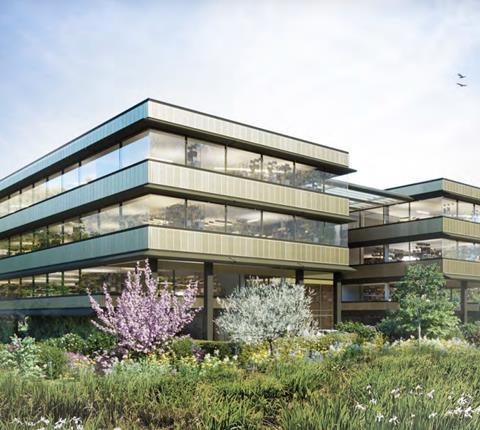Bogle Architects scheme shifted to another part of the site following Historic England objection
The project team behind a life sciences scheme in Oxford have had to shift the proposed building to another part of the site after archaeologists discovered the remains of a medieval nunnery.
The planned footprint of the 90,000sq ft laboratory building, designed by Bogle Architects, was found to be above several previously unknown structures dating from the 12th to 16th centuries including an octagonal pigeon shelter, or dovecote.
Diggers also found a Roman ditch, evidence of ancient pottery manufacturing, Anglo-Saxon field boundaries and a prehistoric peat fen.

The delays have meant the scheme has been hit by new Part L regulations which came into force last year, meaning Bogle has had to improve the building’s energy performance by 40%.
The three-storey building is set to occupy plot 27 of the Oxford Science Park, the campus where Scott Brownrigg scored a planning win last year for a £150m life sciences scheme Mace is set to build which consists of three laboratory and office buildings.
The park will also host part of Foster & Partners’ Ellison Institute of Technology, due to be built by Laing O’Rourke, a sprawling complex of cancer research buildings funded by US billionaire Lawrence J Ellison that will include a geodesic dome library and a 250m-long timber walkway.
Bogle’s revised plans for plot 27 come after Historic England issued an official objection to the scheme, arguing the site’s archaeological discoveries were of “national significance”.
The remains form part of Littlemore Priory, a nunnery established in 1110 which operated continuously until its dissolution under King Henry VIII in 1525 amid scandalous claims of sexual immorality and violent behaviour among its nuns.
Widely publicised contemporary accounts, which are now thought to be partly state propaganda, accused the nunnery’s prioress Katherine Wells of heavy drinking, entertaining men in her parlour and regularly putting nuns in the stocks for extended periods.
But Historic England said the accounts “may paint a false picture of the nunnery which the archaeology could correct.”
“The sparse records for much of the medieval period of Littlemore Priory emphasise the significance of the archaeological remains,” the heritage advisor said.
“The remains on the development site will give information on the working life of the nunnery which is often the least well understood aspect of such institutions.
“Information on medieval women is particularly rare and until recently has been given relatively little attention by historians and archaeologists.”
Bogle’s changes to the scheme to minimise its impact on the remains include moving the building 8m to the north and 9m to the west, meaning four out of six of the historic structures would be avoided by the footprint.
A new “priory garden” designed by LDA Design would also map out the unearthed structures with metal strips, and space has been set aside in the building’s lobby to showcase artefacts discovered during enabling works.
The uplift in the scheme’s energy efficiency has been achieved through “passive solutions, good building design and optimised heating and cooling systems”, consultant Hoare Lea said in an updated energy strategy submitted as part of the revised application.



























No comments yet